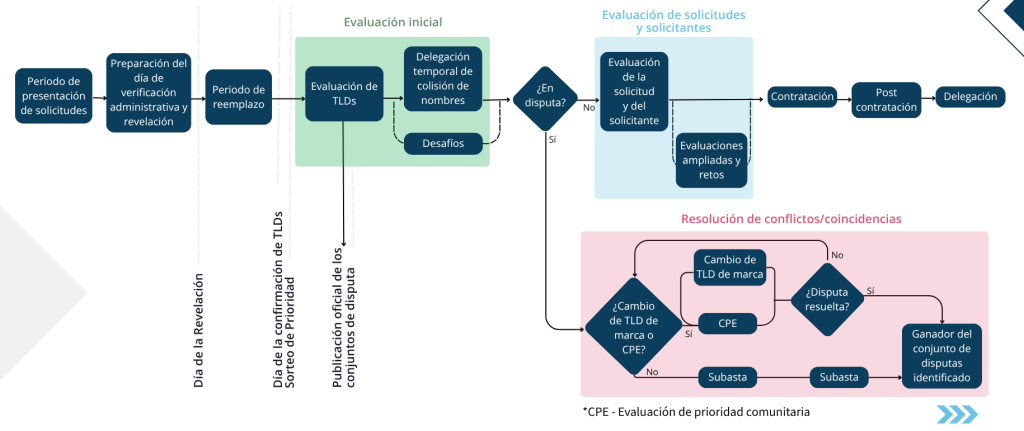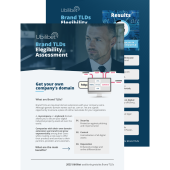A Brand TLD (or “.Brand”) is a top-level domain extension exclusive to a brand (for example, .apple). Unlike generic TLDs, it is not open to the general public. The next application window is projected to open in April 2026, but the Applicant Support Program (ASP) is already open. If you want to secure a Brand TLD, it’s important to start preparing your application now. The ASP is a new feature of this second round, aimed at reducing the barriers and difficulties that some applicants faced in the first round.
Contenidos
How is the application process
While most generic TLDs can be publicly registered, a Brand TLD is exclusively reserved for the requesting brand. This involves stricter legal, technical, and governance requirements, as well as more thorough evaluations by ICANN.

ASP: Applicant Support Program (now open)
In this second round, the Applicant Support Program (ASP) has been created. This is a period during which brands can start getting advice and determine whether they are eligible to apply for their TLD. Some of the requirements include:
-
The organization must be legally established.
-
A Registry Service Provider (RSP) that has been evaluated by ICANN must be identified. This process is already open and will remain available until November 2025. If you are considering submitting an application, now is the time. At Ubilibet, we are an ICANN-approved Registry Service Provider and can assist you throughout the entire process.
Submission of Applications (Q2 2026)
Once the application window opens, brands can submit their request through the ICANN portal. This is where all forms are completed with the legal, financial, technical, and Brand TLD (.brand) information. At this stage, the application fee is paid (with a discount if support from the ASP has been obtained). Once the payment is made, the application moves on to the next phase.
Initial evaluation (Applicant and Brand TLD)
ICANN conducts the initial evaluation in two areas:
- Applicant Evaluation: to verify financial solvency, technical capability, and compliance with legal requirements.
- TLD Evaluation: Where the proposed infrastructure (through the RSP), the feasibility of the TLD, and potential elegibility for Specification 13 are assessed if the TLD corresponds to a registered brand
Objections and Dispute Resolution
After the applications are published, there is a period during which third parties can file objections. These may be based on trademark conflicts, limited public interest, confusion with another TLD, or even community-related issues. ICANN has formal mechanisms to resolve these disputes, including reviews by external experts.
Brand TLD Contention/Conflict Resolution
The “String Contention Resolution” process is triggered when two or more applicants request the same TLD. ICANN establishes several methods to resolve this contention: priority rules (for example, community-based applications), alternative Brand TLDs (if proposed in the initial application), or ICANN-organized auctions. There is also the option to propose an alternative TLD in advance.
Pre-delegation Testing (PDT) and contracting
Once the application is approved and any potential conflicts are resolved, the Registry Agreement with ICANN is signed. This contract establishes the legal, technical, and operational obligations of the future TLD operator, along with the annual fees and compliance requirements. It is at this stage that the applicant can incorporate Specification 13, which officially recognizes the TLD as a Brand TLD and grants specific benefits, such as exemption from offering open public registrations or certain flexibilities regarding registration policies.
Before the TLD can be activated, ICANN conducts technical tests on the applicant’s infrastructure and that of their Registry Service Provider. These tests verify that the TLD meets ICANN’s required standards for security, stability, and performance.
Delegation and Ongoing Obligations
Once the tests are passed, ICANN delegates the TLD into the DNS root zone. From that moment, the Brand TLD becomes active and can be used internally by the brand (for example, for corporate domains or specific services). Once delegated, the TLD must be maintained in compliance with ICANN rules. This includes periodic audits, maintaining security and availability, incident reporting, payment of annual fees, and adherence to current policies.
For .Brand TLDs with Specification 13, it is also required to continuously demonstrate that the TLD continues to meet the exclusive brand-use criteria. ICANN may request periodic reviews and evidence, and if the operator fails to comply with these conditions, they could lose the benefits granted under Specification 13.

Brand TLD duration
A Brand TLD (like other TLDs) is not a domain acquired indefinitely. The new gTLDs resulting from the 2012 program (and those following the new standard for upcoming rounds) are regulated by the Base Registry Agreement, which establishes an initial contract term of 10 years.
At the end of this initial period, the contract is expected to be renewed for successive 10-year terms, provided the domain operator continues to meet its contractual obligations and there are no circumstances preventing renewal.
In other words, a .Brand TLD does not “belong forever” simply because of the initial acquisition: its continuity depends on the brand/operator continuing to comply with the established conditions.
Why act now?
The new Brand TLD application window represents a unique opportunity to strengthen your brand’s digital identity. At Ubilibet, we have the experience and accreditation needed to guide you through the entire process, from preparing the application to the delegation and management of your TLD. If you’d like to explore how a .brand can transform your online presence, our team is ready to help.
Contact us for further information
We will get back to you as soon as possible

